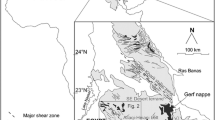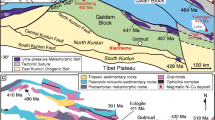Summary
The Bidjovagge gold-copper deposit (69°17'N, 22°29'E) occurs in the north-south trending Proterozoic Kautokeino greenstone belt. The greenstone belt consists of shallow marine sediments and mafic to ultramafic volcanites, which are intruded by diabase sills and granitoids. The sequence can be correlated with the 1930 to 2200 Ma Kiruna greenstone belt. Svecokarelian intrusions took place in two phases between 1880–1890 Ma and between 1860-1870 Ma.
The deposit occurs in the stratigraphically lower part of the belt along a north-south trending anticlinal structure on the border between greenschist and amphibolite grade metamorphism within the Baltic-Bothnia megashear zone. The deposit is related to shear zones and hosted by albitic felsite, a metasomatic rock formed along the contact with the diabase sills.
The only ore minerals of economic significance are native gold and chalcopyrite. Other common ore minerals are pyrite and pyrrhotite. Marcasite, magnetite, ilmenite, hematite, tellurides, rutile, sphalerite, galena, davidite and pentlandite occur in accessory amounts. A total of 10 samples of davidite, 14 sulfides and 4 samples of albitic felsite were analyzed for their isotopic compositions. Our best estimate for the age of the davidites (1885 ± 18 Ma) is based on the upper intersection of a U/Pb concordia diagram and is identified as the time of davidite (and gold) mineralization. This age is confirmed by a Sm/Nd date of 1886 ± 88 Ma on the same material. At 1339 ± 8 Ma, a metamorphic or metasomatic event disturbed the U/Pb system in some of the davidite samples and completely reset the U/Pb ratios in the albitic felsites. The sulfide minerals, containing trace U and Pb, were strongly disturbed during galena formation at about 500–550 Ma but apparently were initially formed at the same time as, or shortly after, the davidite. Based on an estimated time of formation of galena during the development of the early Paleozoic peneplain in the area, the Pb/Pb data are interpreted as a two-stage isochron with an initial age of 1876 ± 15 Ma.
The relation between the mineralization and shear zones, the correspondence between the age of the mineralization and the Svecokarelian orogeny and the initial ratios of the radiogenic isotopes of the ore forming solutions, all support a metamorphic/metasomatic origin for the gold and copper mineralization.
Zusammenfassung
Die Bidjovagge Gold-Kupfer-Lagerstätte (69°17'N, 22°29'E) liegt in dem N-S streichenden proterozoischen Kautokeino Grüngesteinsgürtel. Er besteht aus marinen Flachwassersedimenten, sowie mafischen und ultramafischen Vulkaniten, die von Diabas-Sills und von Granitoiden intrudiert werden. Diese Gesteinsabfolge kann mit dem 1930–2200 Ma alten Kiruna Grüngesteinsgürtel verglichen werden. Sveko-karelische Intrusionen erfolgten zweiphasig, zwischen 1880–1890 Ma und zwischen 1860 und 1870 Ma.
Die Lagerstätte liegt in den stratigraphisch tieferen Anteilen diese Grüngesteinsgürtel entlang einer N-S streichenden Antiklinalstruktur im Übergangsbereich zwischen der Grünschiefer und Amphibolitfazies innerhalb der baltisch-bothnischen Mega-Scherzone.
Sie ist an Scherzonen und an Albit-Felsite, einem metasomatisch am Kontakt mit den Diabas-Sills gebildeten Gestein, gebunden.
Gediegen Gold und Kupferkies sind die wirtschaftlich wichtigsten Erzminerale. Pyrit und Magnetkies sind häufig. Markasit, Magnetit, Ilmenit, Hämatit, Telluride, Rutil, Zinkblende, Bleiglanz, Davidit und Pentlandit kommen akzessorisch vor. 10 Proben von Davidit, 14 Sulfide und 4 Proben von den Albit-Felsiten wurden auf ihre Isotopenzusammensetzung hin untersucht.
Der obere Schnittpukt im U/Pb Concordiadiagramm ergab die beste Altersabschätzung für die Davidite (1885 ± 18 Ma). Dieses Alter wird als Zeitpunkt der Davidit (und Gold)-Mineralisation betrachtet. Ein Sm/Nd-Alter von 1886 ± 88 Ma bestätigt dieses. Ein metamorphes oder metasomatisches Ereignis, datiert mit 1339 ± 8 Ma störte das U/Pb System in einigen Daviditproben und führte zu einer vollständigen Reequilibrierung der U/Pb Verhältnisse in den Albit-Felsiten. Die Isotopenverhältnisse der Sulfide, die Spuren von U und Pb enthalten, wurden während der Bildung von Bleiglanz um etwa 500–550 Ma ebenfalls massiv gestört; die Sulfide wurden aber offensichtlich gleichzeitig, oder aber kurz nach Davidit, gebildet. Basierend auf einer Abschätzung des Bleiglanz-Bildungsalters im Zuge der Entwicklung einer altpaläozoischen Peneplain in diesem Gebiet, werden die Pb/Pb Daten als Zweistufen-Isochrone mit einem Ursprungsalter von 1876 ± 15 Ma interpretiert.
Die Bindung der Mineralisation an Scherzonen, die Übereinstimmung des Mineralisationsalters mit dem der Sveco-karelischen Orogenese und die Isotopeninitiale der erzbildenden Lösungen belegen einen metamorph/metasomatischen Ursprung der Gold-und Kupfervererzungen.
Similar content being viewed by others
Reference
Berthelsen A, Marker M (1986) 1.9-1.8 Ga old strike-slip megashears in the Baltic Shield, and their plate tectonic implications. In:Galson DA, Mueller St (eds) The European Geotraverse, Part 2. Tectonophysics 128: 163–181
Bjorlykke A, Thorpe RI 1982. The source of lead in the Osen sandstone lead deposit on the Baltic Shield, Norway. Econ Geol 77: 430–440.
——Olerud S, Sandstad JS (1985) Metallogeny of Finnmark, north Norway. Norges Geol Unders 403: 113–118.
——Hagen R, Sederholm K (1987) Bidjovagge copper-gold deposit in Finnmark, northern Norway. Econ Geol 82: 2059–2075.
Brooks C, Hart SR, Wendt I (1972) Realistic use of two-error regression treatments as applied to rubidium-strontium data. Rev Geophy Space Phys 10: 551–577.
Cumming GL (1969) A recalculation of the age of the solar system. Can J Earth Sci 6: 719–735.
—Rollett JS, Rosotti FJC, Whewell RJ (1972) Statistical methods for the computation of stability constants. Part 1. Straight-line fitting of points with correlated errors. J Chem Soc, Dalton Transactions: Inorg Chem 2652-2658.
——Eckstrand OR, Peredery WV (1982) Geochronologic interpretations of Pb isotope ratios in nickel sulfides of the Thompson Belt, Manitoba. Can J Earth Sci 19: 2306–2324.
Dodson MH (1973) Closure temperature in cooling geochronological and petrological systems. Contrib Mineral Petrol 40: 259–274.
Faure G (1986) Principles of isotope geology, 2nd edition. John Wiley and Sons, New York.
Gale NH, Mussett AE (1973) Episodic uranium-lead models and the interpretation of variations in the isotopic composition of lead in rocks. Rev Geophy Space Phys 11: 37–86.
Gatehouse BM, Grey IE, Campbell IH, Kelly P (1978) The crystal structure of loveringite-a new member of the chrichtonite group. Amer Mineral 63: 28–36.
Gautier AM, Gulaçar F, Delaloye M (1979) K-Ar age determinations of the Alta-Kvænangen window rocks, northern Norway. Norsk Geol Tidskr 59: 155–159.
Hagen R (1982) The Bidjovagge copper-gold deposit of western Finnmark, Norway. Geol Rdsch 71: 94–103.
Hollander NB (1979) The geology of the Bidjovagge mining field, western Finnmark, Norway. Norsk Geol Tidskr 59: 327–336.
Inkinen O (1979) Copper, zinc and uranium occurrences at Pahtavuoma in the Kittila greenstone complex, northern Finland. Econ Geol 74: 1153–1165.
Krill AG, Bergh S, Lindahl I, Mearns E, Often M, Olerud S, Sandstad JS, Siedlecka A (1985) Rb-Sr, U-Pb and Sm-Nd dates from the Precambrian rocks of Finnmark, Norway. Norges Geol. Unders 403: 37–54.
Ludwig KR, Cooper JA (1984) Geochronology of Precambrian granites and associated U-Ti-Th mineralization, northern Olary province, South Australia. Contrib Mineral Petrol 86: 298–308.
Mathiesen CO (1970) An occurrence of unusual minerals at Bidjovagge, northern Norway. Norges Geol Unders 266: 86–104.
Olerud S (1988) Davidite-loveringite in early Proterozoic albite felsite in Finnmark, North Norway. Mineral Mag 52: 400–402.
Pharaoh TC, Pearce JA (1984) Geochemical evidence for the. tectonic setting of Early Proterozoic metavolcanic sequences in Lappland. Precamb Res 25: 283–308.
Richards JP, Cumming GL, Krstic D, Wagner PA, Spooner ETC (1988) Pb isotope constraints on the age of sulfide ore deposition and U-Pb age of late uraninite veining at the Musoshi stratiform stratiform deposit, Central African Copper Belt, Zaire. Econ Geol 83: 724–741.
Romer RL, Boundy TM (1988) Interpretation of lead isotope data from the uraniferous Cu-Fe-sulfide mineralizations in the Proterozoic greenstone belt at Kopperåsen, northern Sweden. Mineral Deposita 23: 256–261.
Skiöld T (1986) On the age of the Kiruna greenstones, northern Sweden. Precamb Res 32: 35–44.
—— (1987) Aspects of the Proterozoic geochronology of northern Sweden. Precamb Res 35: 161–167.
—— (1988) Implications of new U-Pb zircon chronology to Early Proterozoic crustal accretion in northern Sweden. Precamb Res 38: 147–164.
——,Cliff RA (1984) Sm-Nd and U-Pb dating of Early Proterozoic maficfelsic volcanism in northernmost Sweden. Precamb Res 26: 1–13
——Öhlander B, Vocke RD, Hamilton PJ (1988) Chemistry of Proterozoic processes at a contiental margin in Northern Sweden. Chem Geol 69: 193–207.
Stacey JS, Kramers JD (1975) Approximation of terrestrial lead isotope evolution by a two-stage model. Earth Plan Sci Letters 26: 207–221.
Stevenson R, Cumming GL, Krstic D (1987) Lead-isotope geochronology of the Portman Lake area, Northwest Territories. Can J Earth Sci 24: 2188–2196.
Söderholm K, Nixon F (1988) Geology, exploration and exploitation of high grade gold zones, Bidjovagge mine, Northern Norway. Geological Society of Australia, Bicentennial Gold 88, Melbourne. Extended Abstracts Poster Programme 1: 210–211.
Whittle AWG (1959) The nature of davidite. Econ Geol 54: 64–81.
Author information
Authors and Affiliations
Additional information
With 9 Figures
Rights and permissions
About this article
Cite this article
Bjørlykke, A., Cumming, G.L. & Krstic, D. New Isotopic data from davidites and sulfides in the bidjovagge gold-copper deposit, Finnmark, Northern Norway. Mineralogy and Petrology 43, 1–21 (1990). https://doi.org/10.1007/BF01164218
Received:
Accepted:
Issue Date:
DOI: https://doi.org/10.1007/BF01164218




